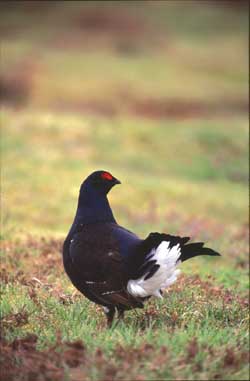
The Game Conservancy Trust, a leading wildlife conservation charity is hoping to raise over £3 million in the next five years in a bid to save the endangered Northumbrian black grouse.
Black grouse were once a common site in North Northumberland, but since the 1970's the species has declined dramatically in both range and numbers due to a number of factors, particularly habitat loss and fragmentation. With only 105 males recorded in 2002, this spectacular bird has become isolated from other groups of black grouse in the North Pennines and the Scottish borders and faces a bleak and uncertain future.
However, a bid for Heritage Lottery Funding by The Game Conservancy Trust could help to secure the future of this rare bird by improving the conditions for black grouse in the region to increase numbers and extend the current range so that it can link to other black grouse groups. This link is crucial to facilitate genetic exchange to maintain the long term viability of the remaining black grouse in northern England.
An initial Project Planning Grant of £50,000 has been awarded by the Heritage Lottery Fund (HLF) to develop a landscape scale conservation strategy for black grouse in Northumberland. Whilst this is not a guarantee of total funding from HLF, it does give the Trust and project partners the opportunity to prepare an application to submit to HLF and a variety of funding sources to achieve the total project cost of £3 million.
Black grouse are a UK Biodiversity Action Plan (BAP) species, with the Game Conservancy Trust and the Royal Society for the Protection of Birds (RSPB) appointed joint lead partners for the plan.
Phil Warren, The Black Grouse Recovery Project Officer said, "We see this project as the next step. It will build on work already underway on the Otterburn Training Area as well as being undertaken by the Cheviot black grouse recovery project and will act as a catalyst to create the desired conditions for black grouse to flourish."
A major undertaking of the recovery project will be to restructure over 100 square hectares of forest edge to create a softer, feathered effect, where shrubs, smaller trees and open spaces can develop. To increase the breeding success of black grouse additional 'keepers will also be employed by the project to reduce predation by foxes, crow, stoats and weasels. Raising public awareness and enlisting the support of landowners are also crucial aspects of the project.
Black grouse are a flagship or indicator species of high quality upland landscapes as they require a mosaic of habitat types including heather moorland, rough grazing allotments, woodland edge habitats and hay meadows. Creating suitable habitats for black grouse therefore has benefits for a host of other species such as golden plover, curlew, short eared owl, merlin and mammals such as the brown hare.
The Black Grouse Recovery Project - a partnership project between The Game Conservancy Trust, Ministry of Defence, RSPB, English Nature and Northumbrian Water - has been running since 1996. Following years of decline the population of black grouse in the North Pennines is now stable and effort is being targeted to expand the range with this part of Northumberland. This new initiative should offer renewed hope for black grouse and The Game Conservancy Trust is confident that this landscape scale enterprise will provide the inspiration to kick-start a full recovery process and thus save a species on the brink.
